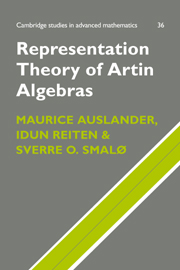Book contents
- Frontmatter
- Contents
- Introduction
- I Artin rings
- II Artin algebras
- III Examples of algebras and modules
- IV The transpose and the dual
- V Almost split sequences
- VI Finite representation type
- VII The Auslander–Reiten-quiver
- VIII Hereditary algebras
- IX Short chains and cycles
- X Stable equivalence
- XI Modules determining morphisms
- Notation
- Conjectures
- Open problems
- Bibliography
- Relevant conference proceedings
- Index
VIII - Hereditary algebras
Published online by Cambridge University Press: 11 May 2010
- Frontmatter
- Contents
- Introduction
- I Artin rings
- II Artin algebras
- III Examples of algebras and modules
- IV The transpose and the dual
- V Almost split sequences
- VI Finite representation type
- VII The Auslander–Reiten-quiver
- VIII Hereditary algebras
- IX Short chains and cycles
- X Stable equivalence
- XI Modules determining morphisms
- Notation
- Conjectures
- Open problems
- Bibliography
- Relevant conference proceedings
- Index
Summary
The representation theory of hereditary artin algebras is one of the most extensively studied and best understood theories developed to date. The theory has served not only as a model for what might be expected of the representation theory of other types of artin algebras, but also as a source of conceptual insights and technical information which have often proven useful in dealing with questions about the representation theory of related but not necessarily hereditary artin algebras, for example tilted algebras.
Our purpose in this chapter is to give an introduction to this extensive theory. While some of the general theory of preprojective, preinjective and regular components of hereditary algebras is developed, we concentrate mainly on hereditary algebras of finite representation type. A bilinear form and its associated quadratic form are given on the Grothendieck group of artin algebras of finite global dimension which is used to give not only a classification of the hereditary artin algebras of finite representation over an algebraically closed field, but also a classification of their modules.
By way of an introduction to the theory of hereditary artin algebras of infinite representation type, the last part of the chapter is devoted to the study of the representation theory of the Kronecker algebra which is the simplest, at least in some respects, of the hereditary artin algebras of infinite representation type. A classification of all modules over the Kronecker algebra is given using the Auslander–Reiten-quiver of the algebra.
- Type
- Chapter
- Information
- Representation Theory of Artin Algebras , pp. 257 - 312Publisher: Cambridge University PressPrint publication year: 1995

